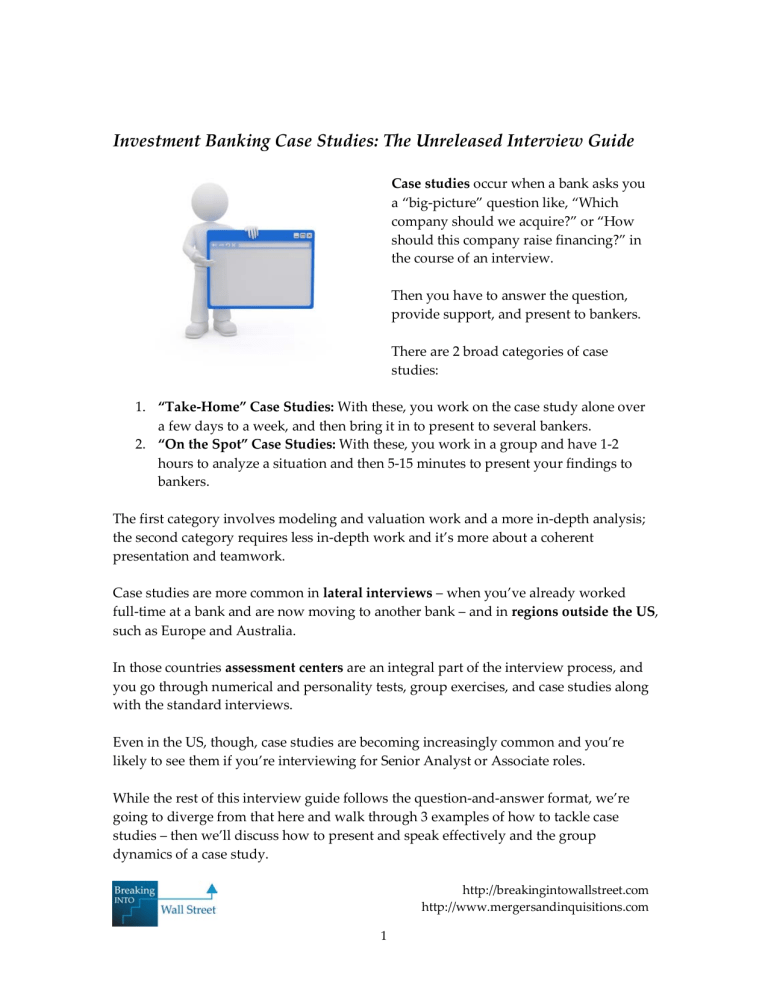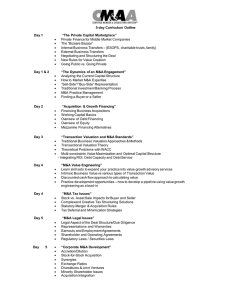
Investment Banking Case Studies: The Unreleased Interview Guide Case studies occur when a bank asks you a “big-picture” question like, “Which company should we acquire?” or “How should this company raise financing?” in the course of an interview. Then you have to answer the question, provide support, and present to bankers. There are 2 broad categories of case studies: 1. “Take-Home” Case Studies: With these, you work on the case study alone over a few days to a week, and then bring it in to present to several bankers. 2. “On the Spot” Case Studies: With these, you work in a group and have 1-2 hours to analyze a situation and then 5-15 minutes to present your findings to bankers. The first category involves modeling and valuation work and a more in-depth analysis; the second category requires less in-depth work and it’s more about a coherent presentation and teamwork. Case studies are more common in lateral interviews – when you’ve already worked full-time at a bank and are now moving to another bank – and in regions outside the US, such as Europe and Australia. In those countries assessment centers are an integral part of the interview process, and you go through numerical and personality tests, group exercises, and case studies along with the standard interviews. Even in the US, though, case studies are becoming increasingly common and you’re likely to see them if you’re interviewing for Senior Analyst or Associate roles. While the rest of this interview guide follows the question-and-answer format, we’re going to diverge from that here and walk through 3 examples of how to tackle case studies – then we’ll discuss how to present and speak effectively and the group dynamics of a case study. http://breakingintowallstreet.com http://www.mergersandinquisitions.com 1 Case Study Example 1: Evaluating Strategic Alternatives (Take-Home) The Scenario: A magazine publisher is evaluating whether it should sell, continue to grow organically, or make small “tuck-in” acquisitions to maximize shareholder value. It is selecting an investment bank to advise on its options, and has requested a presentation from your bank. Your Task: Review the company’s financial and market information and create a 30minute presentation analyzing its options. Recommend a specific course of action – selling the company, continuing to grow organically, or making smaller acquisitions. Materials You’re Given: 10-page overview of company, financial statements, and 5-year projections; 10-page market overview including the major competitors, smaller acquisition candidates, and recent transactions. This case study is more involved than anything you’d see at an assessment center – here’s how you would approach it: 1. First, read through everything and get a sense of the industry, where it’s heading, and how much this company might be worth based on comparables. 2. Complete a brief valuation using public comps, precedent transactions, and a DCF. 3. Weigh the numbers the valuation gives you, the company’s organic growth prospects, and whether or not there are any good companies to acquire. 4. Make a decision – it’s usually best to say “sell” unless the industry is growing quickly (over 10% per year), the company is extremely undervalued, or there are acquisition targets that would boost revenue or profit by at least 20-30%. You could get much fancier with the analysis and look at the company’s valuation now, 5 years from now, and if it acquires 1 or 2 companies, but that isn’t necessary and it may just make your presentation more confusing. Keep this simple and straightforward – the numbers should back up your reasoning, not take over the entire presentation. Once you’ve reached a conclusion, you need to create your presentation and plan out what you’re going to tell the bankers. For a 30-minute presentation where you’re evaluating scenarios like this, go for 10 slides with 3-4 main points each and aim to spend 3 minutes on each slide. http://breakingintowallstreet.com http://www.mergersandinquisitions.com 2 Here’s what you might write if you decide to say, “Sell the company”: • • • • • • • • • • Slide 1: Recommendation to sell and the 3 key reasons why. Slide 2: Industry overview – Is it growing? Shrinking? Stagnant? Slide 3: Company’s position in the industry – Leader? Tier 2 player? Where is it strong / weak? Slide 4: What organic growth would look like 5 or 10 years in the future – how much bigger / more highly-valued would the company be? Slide 5: Potential tuck-in acquisition candidates. Slide 6: Why neither organic growth nor acquisitions are the answer. Slide 7: Why selling now produces the greatest shareholder value. Slide 8: Valuation – Show public comps and precedent transactions. Slide 9: Valuation – Show DCF output and sensitivity table. Slide 10: Conclusion – Re-iterate that selling now is the best option and that neither organic growth nor acquiring smaller companies will result in a higher valuation 5-10 years from now. If you come to a different conclusion – for example, that acquisitions are the best strategy – you would reverse the order and list the solutions you’re not recommending first, concluding with the one you are suggesting. If they don’t give you much information on comparable public companies or precedent transactions, you’ll have to do your own research – Capital IQ is the best source if you’re in finance and have access. Otherwise, you can use Google Finance to find similar companies and search for recent deal activity on the WSJ Deal Blog. You may have to do some industry research to find potential acquisitions – once again, go to Capital IQ first and use Google if you don’t have access. This particular case study is fairly involved – you would not be expected to complete a full valuation or come up with a 30-minute presentation if you only had an hour to prepare at an assessment center. If you want templates for the valuation and DCF part of the case study, check out the free samples offered in the Excel & Fundamentals financial modeling course. And for more detailed guidance on the slides themselves, click here to get my guide to private equity case studies. http://breakingintowallstreet.com http://www.mergersandinquisitions.com 3 Case Study Example 2: Financing Alternatives (On the Spot) The Scenario: A public company is currently trading at a 52-week low – even though recent earnings announcements and the current quarter have been in-line with analyst projections. The management team wants to raise money to finance a new project that could significantly increase profit – how should they raise the capital? Your Task: Create a 5-minute presentation with a recommendation on the best financing method for this scenario. Materials You’re Given: 2-page overview of the company and their financial statements. There are 2 key differences between this case study and the “take-home” variety in the 1st example: 1. This one is less in-depth, and you’re creating a shorter presentation based on less analysis. 2. There is a correct answer – raise debt – as opposed to the example above, which was more subjective. The correct answer is “raise debt” because issuing equity when the share price is already at a 52-week low would result in too much lost ownership. Let’s say that the “normal” share price is $30.00 and there are 10 million shares outstanding, so the market cap is normally $300 million. The 52-week low price is $20.00, so the market cap is now $200 million. If they issued $100 million worth of new shares, that’s 1/4 of their company when the share price is $30.00, but it’s 1/3 of the company when the share price is $20.00. If they raise debt, on the other hand, they will give up no ownership and will face few problems since their financials are otherwise solid. Here’s how you might structure a 5-minute presentation on the topic – in this case you should go for 5 slides (if you’re asked to create slides) and spend 1 minute on each one: • Slide 1: Recommendation and 3 key reasons why (“Debt is better because there’s no dilution, because the company’s financials can support debt, and because the company’s share price is at a 52-week low, so equity financing right now would have higher-than-normal dilution”). http://breakingintowallstreet.com http://www.mergersandinquisitions.com 4 • • • • Slide 2: Why issuing equity is not the solution – show how much of the company they’re giving up now vs. when the share price is more “normal.” Slide 3: Why debt is better and how much they might raise based on their financials (you can base this on a multiple of EBITDA and say 1-2x to be extremely conservative). Slide 4: Possible issues with debt – such as interest expense in future years – and how the company might mitigate them (for example, if its projections show that its pre-tax income greatly exceeds the interest expense). Slide 5: Conclusion – re-iterate why debt is the best solution, how there’s no dilution with debt, and how the company can cover the interest expense. Do not obsess over numbers– make simple estimates such as 1-2x EBITDA, and use round numbers like 5% to 10% for the interest rate to approximate interest expense. If this is a group presentation, make sure each member of your group speaks for at least 1 minute, going over at least 1 of the slides outlined above. This case study was far less involved than the first one, and that’s what you should expect with anything at an assessment center. Case Study Example 3: Potential Acquisitions (On the Spot) The Scenario: A software company is looking to make a significant acquisition. It has identified the company it wants to acquire and has approached a number of investment banks for their views on the deal and how much they should pay. It will select an advisor and decide what to do based on these presentations. Your Task: Create a 5-minute presentation with a recommendation on whether to proceed with the acquisition and, if so, how much to pay for the target. Materials You’re Given: 2-page overview of the buyer and 2-page overview of the seller, with financial information and the metrics and multiples for similar companies. This one is more complicated than example #2 above, but not as in-depth as example #1. You need to answer 2 questions: • • Should they buy the target company? How much should they pay for the target company? The second question is easier to answer than the first: simply look at the information on comparable companies and apply a range of multiples to the target company. http://breakingintowallstreet.com http://www.mergersandinquisitions.com 5 Example: Let’s say the comparable companies are trading at EBITDA multiples ranging from 4x to 8x, with the 25th percentile at 5x, median at 6x, and 75th percentile at 7x. The target company has profit margins and revenue growth in-line with the comparables, so you pick the 25th – 75th percentile range of 5x-7x and apply it to the target company’s EBITDA of $10 million. The buyer should therefore pay between $50 million and $70 million. If you have access to a computer, you can create a DCF as well – but if you don’t have much time, keep it simple and go with multiples. For the “Should they buy?” question, you should consider the following: • • • Does the buyer have enough cash, or can they raise enough debt or issue enough shares to buy the seller? Will the seller add revenue and profit to the buyer? Will the acquisition of the seller result in new customers, new products, new geographies, or other types of synergies for the buyer? Here’s how you might structure a 5-slide / 5-minute presentation to answer this one: • • • • • Slide 1: Yes, they should buy and at price range $xx – $xx / No, they shouldn’t buy and the 3 key reasons why either way. Slide 2: Why the acquisition makes sense strategically / doesn’t make sense strategically – see the points above on products, customers, and geographies. Slide 3: The price range they should pay and why based on the comps, or why the price is problematic if you’re arguing they shouldn’t make the acquisition. Slide 4: Any special conditions or risks you want to note – and how the buyer might mitigate them. Slide 5: Conclusion – re-iterate your decision and the key reasons why. Even though this case study is more complex, you should still avoid stressing over numbers – “on the spot” case studies are more about the clarity of your reasoning and your presentation skills (see below) than complex analysis. Presenting and Speaking Effectively So now that you know how to create presentations to answer case study questions, here’s how you can speak effectively and get all your points across: http://breakingintowallstreet.com http://www.mergersandinquisitions.com 6 • • • • • • • Always practice beforehand, even if it’s just quickly running through an outline of your points. Speak more slowly than you would when talking to someone 1-on-1 – if it feels like you’re speaking too slowly, that’s about right. If you aren’t sure what to say next, pause and look down at your notes rather than saying “um” or “ah” and hesitating. Look around at each banker you’re presenting to and shift your focus to a new person every few seconds. Vary the tone of your voice so that you don’t sound like a drone. You can move around slightly if you want, but always keep your head up and don’t make too many hand gestures. Service with a smile: a simple smile can overcome many other problems such as less-than-engaging content. The biggest mistakes occur when you’re over-prepared or under-prepared: you don’t want to memorize your entire presentation, but you also don’t want to look down at your notes constantly. Do a few practice runs and get the basic outline down, but resist the urge to write out everything or memorize your speech word-for-word. I emphasize keeping everything as simple as possible because complex calculations and ideas are much harder to present and much harder for bankers to interpret. If you follow the “Main point, 3 supporting points” structure throughout, you’ll be much less stressed and your presentations will be much better. The Group Dynamic Remember the first rule of case studies (no, it’s not “don’t tell anyone about case studies”): groups exercises are not competitions. You’re not trying to out-shine everyone else and “impress” bankers – that often backfires because you won’t seem like a team player. This means: • When you’re preparing in a group, do not constantly speak up over everyone else and try to dominate the discussion. http://breakingintowallstreet.com http://www.mergersandinquisitions.com 7 • • • When you’re presenting, make sure each person takes 1 slide and speaks for at least 1 minute. If someone else in your group is not speaking up, ask him/her what he/she thinks about each point you discuss. Keep track of time and make sure you reach a conclusion and have a plan-ofattack in the time allotted. Let’s say you’re given 1 hour to prepare – you should spend 30 minutes reading through the materials and discussing your views with everyone else, and then 30 minutes preparing a plan of attack and the presentation itself. You can get on everyone’s good side by keeping track of the time and making sure you have everything together by the time you need to present. What If You’re Shy? I get this question a lot: “What if I’m not very outgoing? How can I still contribute to group exercises and get a chance to speak up?” Besides my tip above to be the time-keeper and contribute like that, you can do the following: 1. As you’re reading about the company or scenario, come up with 2 points you want to raise and make sure you mention those in the discussion. Set your target “talking points” to a low number so that it’s easy to achieve and so that you don’t get stressed about constantly saying something new. 2. Ask questions rather than feeling pressured to voice your own opinions. If someone says, “I think this company is worth $100 million,” an easy follow-up is, “Why? Are you basing that on just the comps?” The good news is that you don’t have to be particularly outgoing to do well in case studies and group exercises – you just have to present a few points well. More on Case Studies, Interviews, and Modeling While this guide gives you a good idea of what to expect in case studies and how to make your presentations, there’s always room for more. Here’s what I recommend if you’re looking to prepare in more depth for investment banking case studies: http://breakingintowallstreet.com http://www.mergersandinquisitions.com 8 • • • Private Equity Case Studies – PE case studies are slightly different, but there’s a lot of overlap and you can apply many of the tips in this article to IB case studies as well. Investment Banking Interview Guide – For 400 more questions and answers and detailed coverage of everything else related to interviews, check out the full guide. Excel & Fundamentals Modeling Course – There are several interview-ready models in here, including a valuation and DCF template, merger model, and LBO models you can use for case studies. http://breakingintowallstreet.com http://www.mergersandinquisitions.com 9







